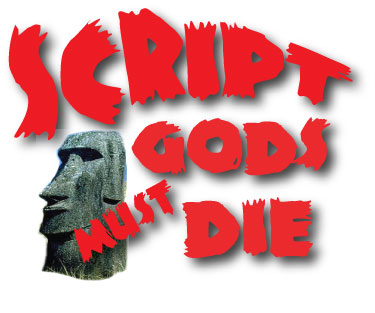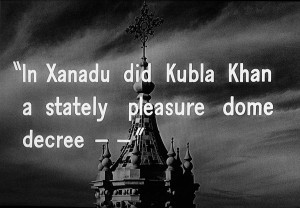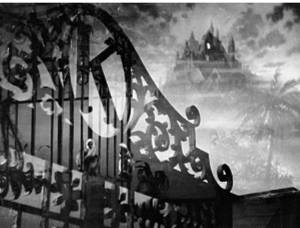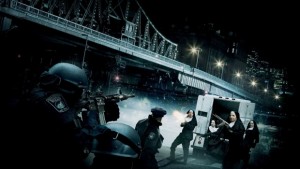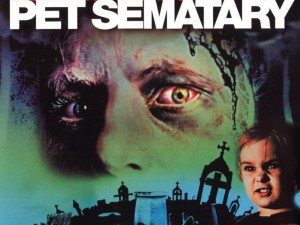So I’ve talked a bit about character introductions and arcs, but what happens when a character isn’t even a person? What about when the living characters are defined by their environment and the locations themselves become a character in the movie? I want to show how this is handled in some well known, and not-so well known, movies. This might take more than one post, but we’ll start here. Let’s begin with AFI’s Top Film of all time….
EXT. XANADU – FAINT DAWN – 1940 (MINIATURE)
Window, very small in the distance, illuminated.
All around this is an almost totally black screen. Now, as the camera moves slowly towards the window which is almost a postage stamp in the frame, other forms appear; barbed wire, cyclone fencing, and now, looming up against an early morning sky, enormous iron grille work. Camera travels up what is now shown to be a gateway of gigantic proportions and holds on the top of it – a huge initial “K” showing darker and darker against the dawn sky. Through this and beyond we see the fairy-tale mountaintop of Xanadu, the great castle a sillhouette as its summit, the little window a distant accent in the darkness.
DISSOLVE:
(A SERIES OF SET-UPS, EACH CLOSER TO THE GREAT WINDOW, ALL TELLING SOMETHING OF:)
The literally incredible domain of CHARLES FOSTER KANE.
Its right flank resting for nearly forty miles on the Gulf Coast, it truly extends in all directions farther than the eye can see. Designed by nature to be almost completely bare and flat – it was, as will develop, practically all marshland when Kane acquired and changed its face – it is now pleasantly uneven, with its fair share of rolling hills and one very good-sized mountain, all man-made. Almost all the land is improved, either through cultivation for farming purposes of through careful landscaping, in the shape of parks and lakes. The castle dominates itself, an enormous pile, compounded of several genuine castles, of European origin, of varying architecture – dominates the scene, from the very peak of the mountain.
The description of Xanadu runs on another two full pages before Kane utters the word “Rosebud”. Everything from the zoo to the golf links to the swimming pool to the minutia of a moat and drawbridge on the epic scale of the fantastical…
A DRAWBRIDGE (MINIATURE)
Over a wide moat, now stagnant and choked with weeds. We move across it and through a huge solid gateway into a formal garden, perhaps thirty yards wide and one hundred yards deep, which extends right up to the very wall of the castle. The landscaping surrounding it has been sloppy and causal for a long time, but this particular garden has been kept up in perfect shape. As the camera makes its way through it, towards the lighted window of the castle, there are revealed rare and exotic blooms of all kinds. The dominating note is one of almost exaggerated tropical lushness, hanging limp and despairing. Moss, moss, moss. Ankor Wat, the night the last King died.
DISSOLVE:
THE WINDOW (MINIATURE)
Camera moves in until the frame of the window fills the frame of the screen. Suddenly, the light within goes out. This stops the action of the camera and cuts the music which has been accompanying the sequence. In the glass panes of the window, we see reflected the ripe, dreary landscape of Mr. Kane’s estate behind and the dawn sky.
Who could live here? Yes, welcome to the world of Charles Foster Kane. Before we even see him, Xanadu has set the otherworldly stage for the character modeled on William Randolph Hurst.
The city itself, the time frame can also enlighten the screenplay, give the reader a good visual foundation on what they’re about to see. And it doesn’t have to be epic like KANE. Take this short example from Miami Vice. The city is in the title so you’ve got to address it, and this does the trick initially in a small, tight paragraph.
AERIAL: THE SIKORSKI crosses past the stacks of $5 million condos to a landing pad on a roof. The Miami of the ’80’s, that twilight-zone frontier built on coke-fueled cash flow, is over. The frontier development stage is passed. It has BECOME Casablanca. Anything goes; everything has a price.
Remember how THE TOWN used the city of Charlestown? It was a living, breathing entity in the movie’s unfolding, as witnessed by this scene.
INT. FBI HALLWAY LEADING TO BULLPEN – MOMENTS LATER
CLOSE ON a STACK OF PAPERS. Frawley lifts them up and we
WIDEN to reveal he is walking down the hall, she is
following. The place is bustling with activity. The
walls are adorned with photos of robberies, mug shots, etc.
FRAWLEY
Three hundred and seventy bank
robberies in Boston last year.
More, per capita, than anywhere in
the world…But guys like this, the hard core
guys, the pros — ninety percent
emanate from a one-square-mile
neighborhood called Charlestown.
We have arrived in a nexus of sorts and on the WALL among
many other maps, photos, etc. is a MAP OF THE CITY WITH
CHARLESTOWN OUTLINED IN RED.
FRAWLEY
Familiar with it….You must be kidding…
Heisting banks is a trade in
Charlestown. Like villages in old
Europe that would specialize in a
certain craft. In the Town it’s armed robbery.
Suffice it to say, if you name your movie after a location, like Pet Sematary, your location is a character, and you better nail the description. Could I live without the freaking ENDLESS CAMERA DIRECTIONS in this screenplay? Oh God, yes. Is it a classic movie? Nah, not really. But for a location as character study, you could do worse…
FADE IN ON
that most persistent summer SOUND: crickets in high grass–
ree-ree-ree-ree… This in dark which slowly
DISSOLVES TO:
EXT. A GRAVE MARKER SUMMER DAY
It’s a plywood cross leaning aslant. Written on the crossarm in
black paint which has faded: SMUCKY HE WAS OBEDIENT. The letters
are faded. They are also straggling and ill-formed–the work of a
child.
MAIN TITLES BEGIN.
EXT. ANOTHER GRAVE MARKER
A child’s printing again, this time on a chunk of warped crating:
BIFFER BIFFER A HELLUVA SNIFFER UNTIL HE DIED HE MADE US RICHER
1971-1974.
MAIN TITLES CONTINUE…
These two markers: IN MEMORY OF MARTA OUR PET RABIT DYED MARCH 1,
1965 (on a wide flat board) and GEN PATTON (OUR! GOOD! DOG!) APRIL
1958 (another board).
We can’t read all of them; some are too faded (or the
“gravestones” themselves too degenerated), but we can see now that
this woodland clearing’s a rather eerie — and well-populated —
animal graveyard.
We can see: POLYNESIA, 1953 and HANNAH THE BEST DOG THAT EVER
LIVED. HANNAH’S tombstone is part of an old Chevrolet hood,
painstakingly hammered flat.
ANGLE ON THE PET CEMATARY
From here we can see most of the clearing, which is surrounded by
forest pines. We can see that the graves–maybe 80 in all–are
arranged in rough concentric circles. On the far side of this
clearing is the end of a path which spills into this graveyard
clearing. The end of the path is flanked by wooden poles which
hold up a crude arch. We can see no writing on this side — the
words on the arch face those arriving along the path.
EXT. THE ARCH, FROM THE PATH SIDE, CU
MAIN TITLES CONCLUDE. Written on the arch in faded black paint is
the work of some long-gone child: PET SEMATARY.
THE CAMERA HOLDS ON THIS FOR A MOMENT OR TWO, THEN PANS SLOWLY
DOWN to look through the arch. From this angle we are looking
across to a deadfall–a tangle of weather-whitened old dead
branches at the back of the graveyard. It’s maybe twenty-five feet
from side to side and about nine feet high. At either end are
thick tangles of underbrush that look impassible.
AS MAIN TITLES CONCLUDE, THE CAMERA MOVES SLOWLY IN on the
deadfall. And as it does, we realize that there is a horrible
snarling face in those branches. Is this an accident? Coincidence?
Our imagination? Perhaps the audience will wonder. THE CAMERA
HOLDS ON IT and then we
DISSOLVE TO:
BLACK. And a white title card: MOVING DAY.
